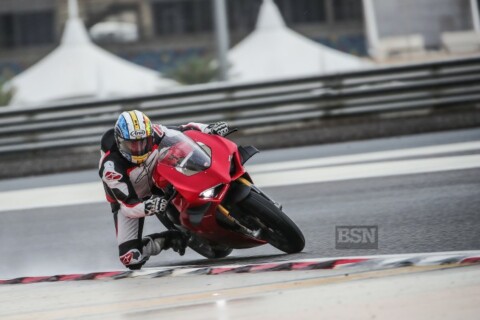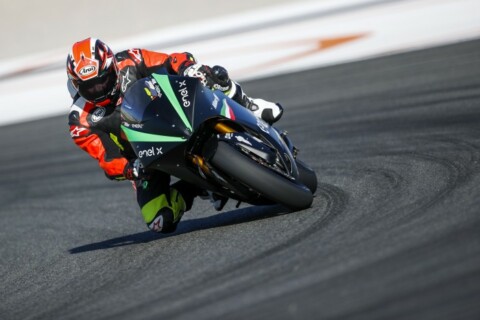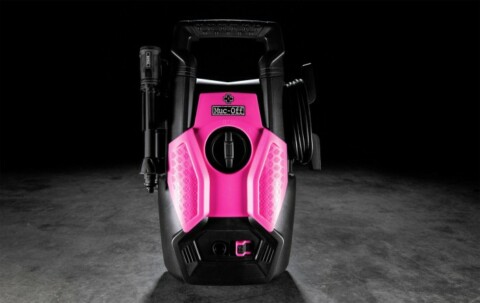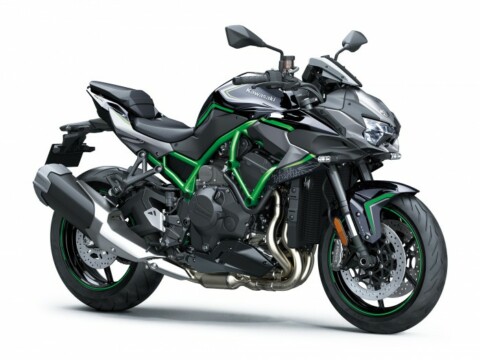Giant launch pics gallery here!
We’re living in a time of mass extinctions. From rhinos in Africa to tigers in Siberia and tuna in the Pacific, a whole slew of beasties are disappearing from the planet. Their habitat’s disappearing, or they’re unlucky enough to have something that’s worth a load of cash: a magical horn, a lovely fur coat, or a tasty belly muscle. Tragic.
There’s another type of beastie in our two-wheeled world that’s facing extinction too though – the 600cc supersports bike. And it’s a properly weird disappearance. Not only was it THE massive class just ten years ago, it’s also an enormously important sector in racing – the various national and international supersport classes, plus Moto2, and a billion club racers all rely on the 120-ish bhp, lightweight track tools.
So what’s gone wrong? Well, in a nutshell, folk ain’t buying them no more, duh! Yamaha showed us a graph at the 2017 R6 launch in Almeria tracking the decline of the sector from 2006. The financial crisis played a part in the overall decline of course, but sales have been utterly decimated, the European figures dropping from almost 50,000 bikes, to less than 5,000 last year. Eek. In the showroom, folk are moving away from sportsbikes in favour of nakeds and adventure machines, while those who do stick with race rep machines are going the whole hog and buying litre-class superbikes instead.
The final nail in the coffin was the introduction of Euro 4 emissions rules for this year. To comply with those meant all the manufacturers would have had to redesign their 600cc engines – a costly exercise, with questionable return. And the majority didn’t bother: meaning you can’t now buy a new Honda, Kawasaki, Suzuki or Triumph supersports 600 bike. The CBR600RR, ZX-6R, GSX-R600 and 675 Daytona are all now ex-bikes. They have ceased to be.
All of which makes Yamaha’s decision to sort its R6 supersports bike out for 2017 very interesting indeed. Do they know something we don’t? Are they content to be the only player in the field, and preparing for some kind of a gigantic, worldwide, distributed R6 Cup? Or have they made a boo-boo?
We’re here in Almeria to find out part of the answer at least, which is to say, is the new bike any good? On paper, there’s a lot of smart stuff going on: an all-new front end borrowed from the R1, with new 43mm forks instead of 41mm chappies, plus 10mm bigger 320mm brake discs, a new traction control setup, ABS, and a quickshifter. Meanwhile a new magnesium rear subframe and aluminium fuel tank save enough mass that even with all the extra new Euro 4 gubbins, the bike has only gained 1kg over the old ‘un.
It’s not all gravy though: the aforementioned emissions gubbins have sapped a bit of power from the engine, which is down anywhere from six to 11bhp at the peak, depending on which year you compare it with. Indeed, the 116.8 claimed horses is the lowest figure since the 2004 model. Erk. While we’re having a moan, the quickshifter only works on up-changes, and the ABS can’t be turned off. Gah.
At the track though, I’m pushing any negative thoughts to the back of my mind. One thing they have got right is the new styling: borrowing the blank, massive-foreheaded style of the R1 for the front end, with awesome LED position and headlights tucked into the nosecone. It’s also claimed to be much more aerodynamic, and there’s a smart new tail unit, complete with big air vents. Nice. The rest of the bike looks super-purposeful, and is a real antidote to the sort of retro hipster nonsense which we’re seeing too much of these days. This, for me, is a Proper Bike.
Time for a spin then. I’ve been to Almeria a few times before, but not for a while. So the first few laps (behind BSS champion Tarran Mackenzie, who’s come along for the jaunt) are steady away, as I get my head round the blind crests, altitude changes, nice long back straight and tricksy tightening bends here and there. Back in after the sighting laps, and then we’re off for a proper blat.
I’m confused at first though. I’ve not been on track on a 600 for a while, and the last big track session I had was on Honda’s Fireblade. So I’m flummoxed a bit at the lack of oomph. Then I retune my ears 4,000rpm higher, start to thrash the living bejayzuz out of the little Yamaha, and it all gets much better. The new quickshifter is excellent, throwing lightning-fast changes into the box with ease, and the fuelling is clean enough. But already I’m feeling a hint of flatness about the power that’s not just down to being a 600. On the uphill sections at Almeria, there’s a definite lull in proceedings, as you give it full gas, and wait for the intake noise to change from a bit of a yawn to more of a scream. It gets there in the end, but even on the flat back straight, I’m struggling to get into fifth for more than a couple of seconds before braking. Hmmm.
Fortunately, the rest of the bike is working a treat. The new brakes are stonking, with heaps of power and feel, and though some of the racer-journos complain a bit about the ABS getting in their way, I’m finding it just fine. Yamaha’s swapped out the stock Bridgestone S21 road-sporty tyres for R10 trackday rubber, and despite looking pretty worn after a session or two, the R10s don’t give me any problems at all. They don’t have the spectacular performance of something like the firm’s V02 slicks, but for today, they’re spot-on.
The basic geometry of the R6 hasn’t really changed, so it’s still the same sharp-steering, yet precise track tool it always was. On the long, long left-hander at Almeria, you can easily put it where you like. The new suspension doesn’t feel massively special, but just gets on with the job in hand, leaving you free to think about other stuff.
We’ve done a fair few laps this morning now, but Yamaha’s got a treat in store for us next. They’ve brought along some tweaked bikes, to let us have a taste of what the bike feels like without the Euro 4 stuff. Now, occasionally on bike launches in the past, the manufacturer would slip in a cheeky Mickey Finn – a sneaky upgrade to the test bikes. Nothing serious – no tuned big-bore motors or the like, more like an ‘optional’ race can, better tyres, or maybe £5k of luxury dealer-fit upgrades. The point being to make the journo’s experience of the bike as good as it can be.
Now Yamaha’s being pretty open here: these bikes haven’t got any big mechanical changes – they’ve just got a pipe and a race kit ECU. A full Akrapovic race pipe dumps the catalysts, and the ECU gives optimal fuelling for performance rather than emissions, so it’s the equivalent of what most owners will consider anyway – a pipe and a Power Commander kinda thing. They’ve also taken off some road kit – but just stands, numberplate holder and the like. Will this stage-one tune make much difference?
Bugger me, yes it does. There are two big improvements – the engine suddenly comes alive, with wheelbarrow-loads of extra grunt all through the upper midrange and top-end. But the weight loss – estimated around 10kg or so – has also livened up the handling too. It’s now a proper little rocketship, screaming away up the hills without a pause – and I get the chance to confirm that, yes, it does have a sixth gear, down the back straight. But the bike also feels more controlled when hard on the brakes, and there’s an extra level of plantedness when deep in the middle of Almeria’s long bends. The cherry on the icing on the cake? You get an auto-blipping down-changing quickshifter built into the kit ECU, which is a fantastic aid to going faster (as well as sounding awesome). It’s a fabulous package now – and much closer to the bike I was dreaming of riding round here.
For the last session I’m back on a stock bike, but it’s not a hardship really. I’ve finally managed to put together a coherent plan for some of the trickier parts of Almeria, helped by the extra poise and power of the kitted bike, and I have my most fun session of the day. I’m tired, sure, but it’s a lot easier to manhandle a 600 than a litre bike, so I’ve still got some fitness reserves in store. The grin just gets wider and wider under my Arai, as I whistle round a sunny, dry, warm Almeria – perhaps the perfect habitat for this rare, endangered creature underneath me.
So – should we be starting a campaign to save the 600, like the environmentalists do for rhinos, tigers and tuna? I think so, yep. Not only do we need them for supersport racing, we also need them as a vital part of the racing environment worldwide. Things are okay now, with loads of used bikes around. But in a few years’ time, things will get tougher, and we’ll be stuck with glorified R6 Cup racing (with a few MV Agusta F3 675s floating about). That wouldn’t be a total disaster (especially for Yamaha, haha). But do you want to live in a world without the Siberian tiger, the bluefin tuna and a thriving 600cc class? I know I don’t…
Engine
High-revving 599cc four is unchanged internally, apart from a new gear position sensor mounted in the crankcases. That allows a new ECU to use a different map for each gear, optimizing fuelling. There’s a new exhaust with more catalysing powers and two O2 sensors instead of one, and the fuel injection’s been tweaked too.
Frame
Main frame is as you were – but there’s a new slimmer, lighter rear subframe, made from magnesium and fairy dust. Fuel tank is aluminium too, saving 1.2kg
Suspension
Rear suspension is new, but basically similar to before. Front forks are KYB 43mm USD units, up from the 41mm ones used before. They’re the same type as the latest R1, but with different internal settings obviously.
Brakes
We get 10mm larger front discs, now 320mm puppies, with the same four-piston radial calipers. New ABS system can’t be switched off, and isn’t an IMU-based leaning setup, but works well.
Electronics
New traction control system has six levels, plus off, which is probably about four levels too many… There are three power modes, A (sharpest), Standard (err, standard) and B (softest). We just stuck with A on the track. The quickshifter only works on upchanges as stock, but the race kit ECU adds a downshift auto-blipper too. We imagine the ECU flashing gods are already onto this deviancy…
The R6 is also compatible with Yamaha’s optional CCU Communication Control Unit GPS datalogger, as used on the R1.
SPECS
Price: £10,999
Engine: 16v inline-four, DOHC, liquid cooled, 599cc
Bore x stroke: 67x42.5mm
Compression ratio: 13.1:1
Max power (claimed) 116.8bhp@14,500rpm
Max Torque (claimed) 45.5ft lb@10,500rpm
Transmission: six speed, slipper clutch, chain drive
Frame: aluminium twin spar
Front suspension: 43mm USD KYB forks, fully adjustable
Rear suspension: KYB monoshock, fully adjustable
Brakes: Dual 320mm discs, four-piston calipers (front), 220mm disc, single-piston caliper (rear), ABS
Wheels/tyres: Cast aluminium/Bridgestone S21, 120/70 17 front, 180/55 17 rear
Rake/trail: 24°/97mm
Wheelbase: 1,375mm
Kerb weight (claimed, full fuel tank): 190kg
Fuel capacity: 17 litres
Rider Aids: ABS (non-switchable), D-Mode power modes, six-level switchable traction control system up-only quickshifter.










